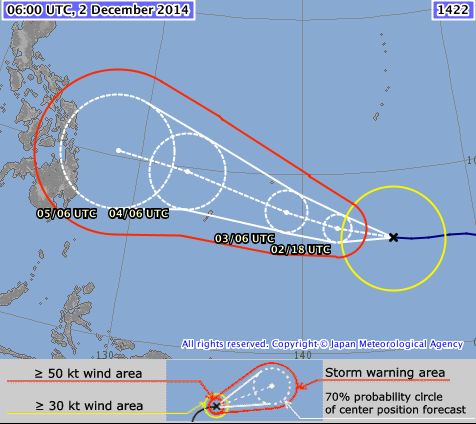The Tropical Storm Hagupit (Bagyong Ruby) is likely to intensify into a typhoon before it enters the Philippine Area of Responsibility on Thursday, December 4, 2014. According to PAGASA’s forecast, the weather disturbance is expected to produce a storm surge of 3 to 4 meters once it enters the Philippines this coming weekend. PAGASA also release an Hourly Update of the Tropical Storm “Hagupit” through their official website.
Here’s the Hourly Update of Bagyong Hagupit (Ruby):
- Updating….
- 11 PM (Dec. 2, 2014) – was estimated at 1825 km East of Mindanao (6.3°N, 143.1°E). Maximum winds of 105kph and gustiness of up to 135kph. Forecast to move West Northwest at 30kph.
Senior weather forecaster for PAGASA, Rene Paciente stated in a televised press briefing that Hagupit was last observed 2,325 kilometers east of Mindanao. The storm packed maximum sustained winds of 75 kilometers per hour (kph) near the center and gusts of 90 kph. It was forecast to move west northwest at 35 kph.
The name “Hagupit” is just one of the few name contribution of the Philippines to the international typhoon names. Some of the name contribution of the Philippines includes the following names: Maliksi, Danas, Lupit, Talas, Cimaron, Hagibis, Molave, Malakas, and Talim.
Hagupit, the international name of Bagyong Ruby is a Filipino word for “whip,” it is expected to enter PAR before noon on Thursday, December 4, 2014.
According to PAGASA, there are two scenarios for Tropical Storm Hagupit (Bagyong Ruby) as it nears the Philippines.
One of the two scenarios is that it would landfall in Eastern Visayas, and its strength before making a landfall would be between 150 and 175 kph. During the first case scenarios a storm surge of 3 to 4 meters is also possible.
The second scenario for Bagyong Hagupit, it will recurve to the north toward southern Japan and will not make a landfall in the Philippines. The permanent high pressure area in Northern Philippines will greatly affect the outcome of Bagyong Hagupit. Once the high pressure area in Japan slows down, Bagyong Hagupit will not hit the country but if the high pressure area in Japan will intensify, Bagyong Hagupit will surely affect the areas of the Visayas Region.

